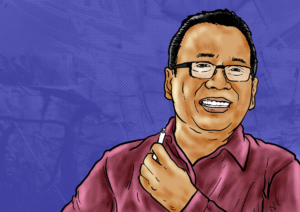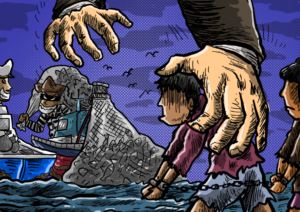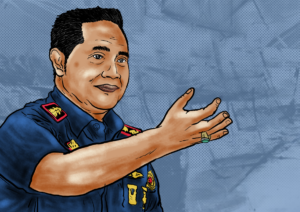Apparently, Thai protesters know exactly how to effectively break the concentration of security apparatus on guard when these guards start to act violently against them.
“When the security apparatus started to take repressive actions against the protesters, the protesters quickly dispersed to several different spots. This dispersion gave the security apparatus a really hard time because the protesters could quickly spread to four or five different zones simultaneously,” said woman activist Ivana Kurniawati during an online discussion themed Taking a Look at Thailand’s Pro-democracy Movement organized on Tueday, Oct. 20 by non-governmental organization Migrant Care.
Ivana, who has been living in Thailand for two years, said that the security apparatus had always responded to protesters with repressive measures ranging from actions like spraying tear gas, shooting dissolved chemical substances using water cannons as well as downright nabbing the field leaders of the protests.
“Yet these are just peaceful protests,” she explained.
Yet, she said, the security apparatus’ repressive actions did not by any means cooled down the waves of demonstrations which had already been going on for nine months. Instead of backtracking, the protesters have come back with a revenge, armed with more sophisticated strategies. They have adopted some of these strategies from the Hong Kong demonstrations last year, according to Ivana.
To protect themselves from the guards’ assaults, for instance, the protesters had already carried some umbrellas, armors and helmets. They were standing on the frontline to protect other protesters against the tear gas sprayed by the guards.
At the same time, they also took advantage from cutting-edge technology such as using Google Maps to share the assembly points before they started taking to the street.
Speaking at the same event, Dewi Ratnawulan, an Indonesian researcher living in Thailand, also evaluated the Thai pro-democracy activists’ demonstration strategies positively.
Dewi said that these activists could organize their protests in a very meticulously planned manner: judging from the way they were using non-verbal language during a protest, for instance: pointing toward their foreheads to request helmets from their fellow protesters, or crossing their fingers to signal the marching protesters to stop moving forward immediately.
“At 8 p.m., when the protests ended, they returned home to rest before continuing the demonstrations the next day,” Dewi said.
She also said that the Thai youngsters were able to employ creative tactics to respond to changing situations during the demonstrations and that these youngsters had been attracted to join these protests in the first place because they wanted to apply their street-smarts there.
For instance, during the evening, the masses were asked to turn their smartphone on and raise them up to lit up the sky, following the protest leader’s instructions on how to create a wave of light.
***
The Thai demonstrators are basically demanding three things: that the Prime Minister Prayuth Chan-o-cha stepped down from his position (Chan-o-cha was a former military commander who launched the 2014 coup), constitutional amendment and monarchy reform. The three demands are symbolized in the three-finger salute, a gesture that was popularized by the 2012 film The Hunger Games.
The third demand to reform the monarchy system cannot be separated from the lese-majeste policy prohibiting Thai citizens from insulting the royal family. Those who dare violate the prohibition would be punishable with 15 years of imprisonment.
Ivana said that the months-long protests could not be separated from the forcible disbandment of the pro-democracy, oppositional political party called the Future Forward Party (FFP).
During the 2019 Elections, the FFP was able to secure 80 parliamentary seats, making it the third most supported party during the elections. Unfortunately, the party, which had just been established in March 2018, was short-lived.
The Thai court decided to disband the party in February 2020 on charges of violating political party funding regulation.
“The dissolution of the political party triggered the political consciousness of youngsters, that there was actually something wrong with their national politics. This propelled them to conduct their demonstrations,” Ivana said.
Furthermore, Ivana said, the abduction of Waanchalerm Satsaksit, a Thai political activist which had subsequently sought exile to Cambodia, which was allegedly done by the government and the military junta, added more fuel to the Thai people’s furiously burning fire.
“[Abductions like this] has happened quite frequently in Thailand; this is by no means the first time that this happened here. What most devastated the young generation was the fact that the victims of the forced disappearances were youngsters like them, thus triggering their anger,” Ivana said.
***
Meanwhile, Asia Democracy Network secretary-general Ichal Supriadi said that forced disappearance of several activists were only the tip of the mass protests iceberg.
“The Thai youngsters had already been planning their movement carefully for a very long time. It only took one person to set these things into motion,” Ichal said.
The student movement in Thailand, he continued, could not be separated also from Asia’s already established pro-democracy network. Thailand, according to Ichal, is the hotspot of the international human rights movement. No wonder, many other prodemocracy movements in Asia had also been born in the nation.
Ichal believed that the three-finger salute movement would still be going on for a long time in Thailand because the country’s authoritarian power triangle – the military junta, local tycoons and the royal family – was quite hard to get rid of.
“This is a big living laboratory showing different parties which struggle to retain their positions,” he said.
A Flinders University Muangthai studies researcher in Adelaide, Australia, Priyambudi Sulistiyanto explained that there was a difference between the movement taking place right now compared to the protests which was taking place in the 1970s era. During the decade, he said, Priyambudi said that there was a battle between the military junta, aided by the royal family, against the pro-democracy alliance driven by university students.
“Thai student movement in today’s context is more fluid; the movement doesn’t follow the old hierarchy led by certain figures or leaders,” he said.
The man who wrote a dissertation about Southeast Asian political movement kept calling on for researchers to not hastily taking sides with the Thai prodemocracy movement. He said that such movements in Thailand had never been separated from political coups and he believed that the ongoing unrest was merely part of an unfinished political karma.
“We don’t know whether this movement is supported by some business conglomerates or whether the students raise their funds independently: we need to look at this very carefully,” he said.







